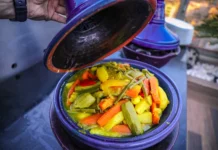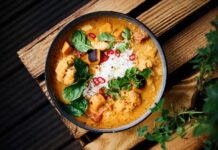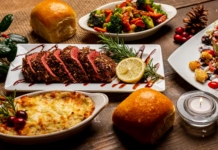Couscous, a staple dish in Moroccan cuisine, is more than just a grain; it’s a symbol of hospitality, community, and culinary artistry. This guide will take you on a journey through the art of preparing authentic Moroccan couscous, from selecting the right ingredients to mastering the techniques that transform simple semolina into a flavorful and satisfying meal.
Understanding Moroccan Couscous:
Moroccan couscous isn’t simply steamed semolina. It’s a complex dish, often featuring tender meat (usually lamb, beef, or chicken), a medley of seasonal vegetables, and a rich, aromatic broth. The semolina itself is meticulously prepared, steamed multiple times to achieve a light and fluffy texture. The entire process is a labor of love, a testament to the importance of food in Moroccan culture.
Ingredients: The Building Blocks of Flavor:
- Couscous (Semolina): Use medium-grain semolina for the best results. Avoid instant couscous, as it won’t have the same texture or flavor. Pre-cooked couscous can be used as a shortcut, but the traditional method yields a superior result.
- Meat: Lamb is the most traditional choice for Moroccan couscous, but beef or chicken can also be used. Choose a cut that benefits from long, slow cooking, such as lamb shanks, beef chuck, or chicken thighs.
- Vegetables: A variety of vegetables can be used, depending on the season and personal preference. Common choices include carrots, zucchini, turnips, pumpkin, cabbage, and chickpeas.
- Onions: Onions form the base of the flavorful broth. Use yellow or white onions.
- Spices: Moroccan cuisine is renowned for its use of spices. A typical couscous spice blend includes ras el hanout (a complex mix of spices), turmeric, ginger, cumin, coriander, and cinnamon.
- Oil: Use a neutral-flavored oil, such as vegetable oil or olive oil.
- Broth: Water or chicken broth can be used. For a richer flavor, use a combination of both.
- Dried Fruits (Optional): Dried apricots, raisins, or dates can be added for a touch of sweetness.
- Nuts (Optional): Toasted almonds or other nuts can be used as a garnish.
- Herbs: Fresh parsley and cilantro are commonly used as garnishes.
Equipment: Essential Tools for Success:
- Couscoussier: This is a specialized pot used for steaming couscous. It consists of a large pot for the broth and a smaller, perforated pot (the “keskass”) that sits on top for steaming the couscous. If you don’t have a couscoussier, you can improvise with a steamer basket placed over a pot of boiling water.
- Large Bowl: For preparing the couscous.
- Wooden Spoon or Spatula: For stirring and fluffing the couscous.
- Fine-Mesh Sieve: For sifting the couscous.
The Art of Preparing the Couscous (Traditional Method):
- First Steaming: In a large bowl, place the dry couscous. Gradually add lukewarm water, mixing with your hands until the couscous is evenly moistened. The couscous should feel slightly damp but not soggy. Let it sit for about 15 minutes to allow the semolina to absorb the water.
- Sifting: Using a fine-mesh sieve, sift the couscous to separate the grains and remove any clumps.
- First Steaming (in the Couscoussier): Fill the bottom pot of the couscoussier with water or broth and bring it to a boil. Place the couscous in the top pot (keskass). Make sure the steam can circulate freely. Steam the couscous for about 15-20 minutes, or until steam rises from the couscous.
- Second Steaming: Remove the couscous from the keskass and place it back in the large bowl. Add a little more lukewarm water, mixing with your hands to loosen the grains. Be careful not to add too much water; the couscous should still be loose and not sticky. Add a pinch of salt. Return the couscous to the keskass and steam it again for another 15-20 minutes.
- Third Steaming: Repeat the process of moistening and steaming the couscous one last time. This final steaming is crucial for achieving the desired light and fluffy texture. Before the third steaming, you can gently incorporate a little bit of butter or olive oil into the couscous for added richness.
Preparing the Broth and Vegetables:
- Sauté the Onions: In the bottom pot of the couscoussier (or a large pot), heat the oil and sauté the onions until they are softened and translucent.
- Add the Meat: Add the meat to the pot and brown it on all sides.
- Add Spices: Add the ras el hanout, turmeric, ginger, cumin, coriander, and cinnamon. Stir well to coat the meat and onions with the spices.
- Add Liquid: Add water or broth to the pot, enough to cover the meat. Bring to a boil, then reduce the heat and simmer for about 1-2 hours, or until the meat is tender.
- Add Vegetables: Add the vegetables to the pot, starting with the ones that take longer to cook, such as carrots and turnips. Add the softer vegetables, like zucchini, towards the end. Add the chickpeas (if using) at this stage as well.
- Simmer: Continue to simmer until the vegetables are tender but not mushy. Adjust the seasoning with salt and pepper to taste. If you are using dried fruits, add them in the last 30 minutes of cooking.
Assembling the Couscous:
- Fluff the Couscous: Before serving, fluff the couscous with a fork or your hands to separate the grains.
- Arrange the Couscous: Place a mound of couscous on a large serving platter.
- Add the Meat and Vegetables: Arrange the meat and vegetables around the couscous.
- Ladle the Broth: Ladle some of the broth over the couscous and vegetables.
- Garnish: Garnish with fresh parsley and cilantro. Sprinkle with toasted almonds or other nuts, if desired.
Serving Moroccan Couscous:
Couscous is traditionally served communally, with everyone eating from the same platter. Use your right hand (or a spoon) to scoop up the couscous, meat, and vegetables.
Tips and Variations:
- Vegetarian Couscous: Omit the meat and use vegetable broth. Add more vegetables, such as butternut squash, sweet potatoes, and bell peppers.
- Chicken Couscous: Use chicken pieces instead of lamb or beef.
- Seven Vegetable Couscous: A popular variation featuring seven different vegetables, each with symbolic meaning.
- Sweet Couscous: A dessert version of couscous, often served with milk, butter, and sugar.
- Use a Pressure Cooker: You can use a pressure cooker to shorten the cooking time for the meat and vegetables.
Mastering the Art:
Making authentic Moroccan couscous takes practice. Don’t be discouraged if your first attempt isn’t perfect. With time and patience, you’ll develop a feel for the process and be able to create a delicious and memorable meal.
A Culinary Journey:
Preparing and sharing Moroccan couscous is more than just cooking; it’s a cultural experience. It’s a way to connect with the rich culinary traditions of Morocco and to share a delicious and satisfying meal with family and friends. So, gather your ingredients, embrace the process, and embark on your own culinary journey into the heart of Moroccan cuisine. Enjoy!


























